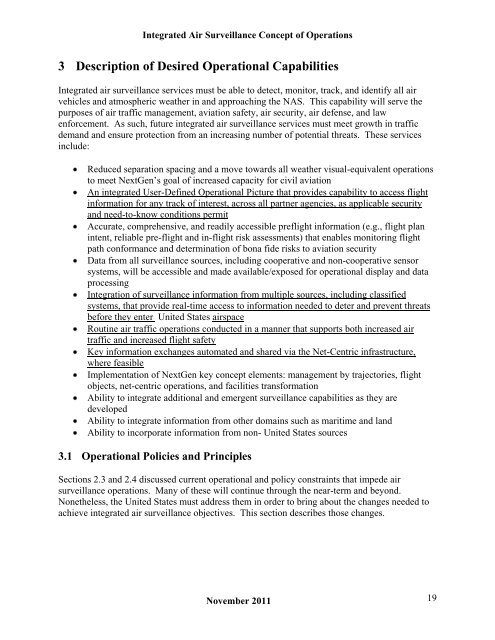Integrated Air Surveillance Concept of Operations - Joint Planning ...
Integrated Air Surveillance Concept of Operations - Joint Planning ...
Integrated Air Surveillance Concept of Operations - Joint Planning ...
Create successful ePaper yourself
Turn your PDF publications into a flip-book with our unique Google optimized e-Paper software.
<strong>Integrated</strong> <strong>Air</strong> <strong>Surveillance</strong> <strong>Concept</strong> <strong>of</strong> <strong>Operations</strong><br />
3 Description <strong>of</strong> Desired Operational Capabilities<br />
<strong>Integrated</strong> air surveillance services must be able to detect, monitor, track, and identify all air<br />
vehicles and atmospheric weather in and approaching the NAS. This capability will serve the<br />
purposes <strong>of</strong> air traffic management, aviation safety, air security, air defense, and law<br />
enforcement. As such, future integrated air surveillance services must meet growth in traffic<br />
demand and ensure protection from an increasing number <strong>of</strong> potential threats. These services<br />
include:<br />
Reduced separation spacing and a move towards all weather visual-equivalent operations<br />
to meet NextGen’s goal <strong>of</strong> increased capacity for civil aviation<br />
An integrated User-Defined Operational Picture that provides capability to access flight<br />
information for any track <strong>of</strong> interest, across all partner agencies, as applicable security<br />
and need-to-know conditions permit<br />
Accurate, comprehensive, and readily accessible preflight information (e.g., flight plan<br />
intent, reliable pre-flight and in-flight risk assessments) that enables monitoring flight<br />
path conformance and determination <strong>of</strong> bona fide risks to aviation security<br />
Data from all surveillance sources, including cooperative and non-cooperative sensor<br />
systems, will be accessible and made available/exposed for operational display and data<br />
processing<br />
Integration <strong>of</strong> surveillance information from multiple sources, including classified<br />
systems, that provide real-time access to information needed to deter and prevent threats<br />
before they enter United States airspace<br />
Routine air traffic operations conducted in a manner that supports both increased air<br />
traffic and increased flight safety<br />
Key information exchanges automated and shared via the Net-Centric infrastructure,<br />
where feasible<br />
Implementation <strong>of</strong> NextGen key concept elements: management by trajectories, flight<br />
objects, net-centric operations, and facilities transformation<br />
Ability to integrate additional and emergent surveillance capabilities as they are<br />
developed<br />
Ability to integrate information from other domains such as maritime and land<br />
Ability to incorporate information from non- United States sources<br />
3.1 Operational Policies and Principles<br />
Sections 2.3 and 2.4 discussed current operational and policy constraints that impede air<br />
surveillance operations. Many <strong>of</strong> these will continue through the near-term and beyond.<br />
Nonetheless, the United States must address them in order to bring about the changes needed to<br />
achieve integrated air surveillance objectives. This section describes those changes.<br />
November 2011 19
















